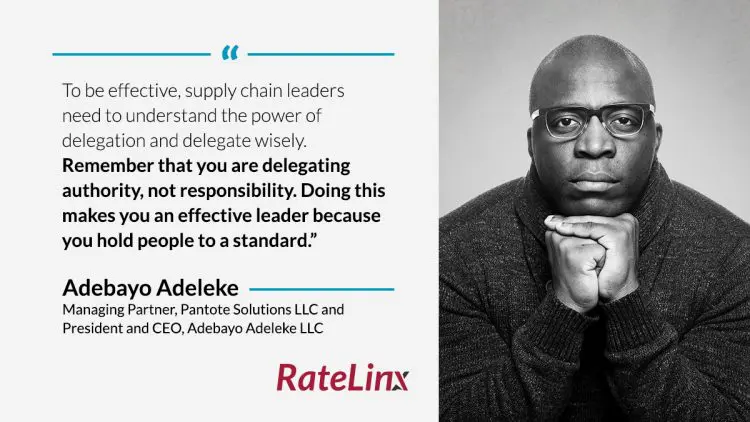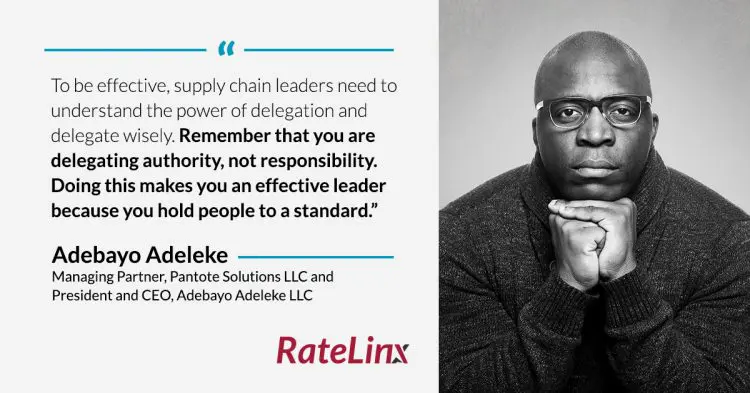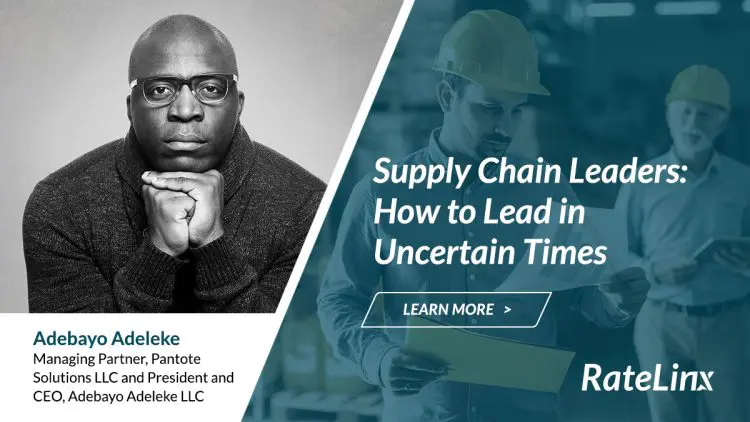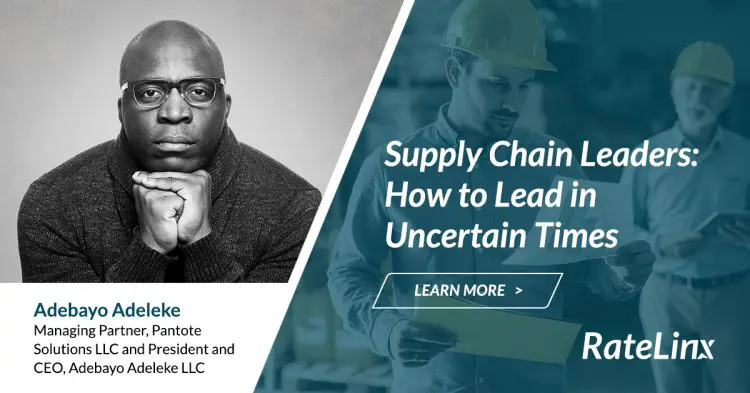A great supply chain leader distinguishes themselves most during times of adversity. They lead when the path forward is uncertain, confident in their ability to help others overcome strife and struggle.
To lead takes strength and courage, determination, and resilience. It makes sense, then, that so many successful leaders come from military backgrounds. These institutions are dedicated to recognizing, refining, and polishing these traits.
Featured Expert
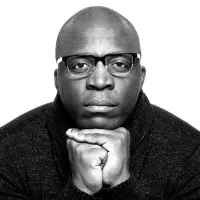
Adebayo Adeleke
Adebayo is a retired U.S. Army Officer, supply chain enthusiast, businessman and social entrepreneur. His military career is broadly defined by exposure to some of the world’s most stringent supply chain practices. Today, Adebayo spends his time as a Managing Partner at Pantote Solutions LLC in Dallas, TX, and is also the President and CEO of Adebayo Adeleke LLC, a Principal Partner and Senior Supply Chain Consultant for Epot Consulting Limited. He’s also a lecturer in supply chain management at Sam Houston State University.
Recommended Reading:
Adebayo Adeleke is a voice for leadership in an industry that needs stewards now more than ever. His profound knowledge and expertise in the fields of risk management and security, supply chain management and logistics, leadership and geopolitics, diversity, and inclusion make Adebayo a positive influencer, thought leader and generator of authentic ideas and novel scenarios that birth winning experiences for individuals, organizations, and governments. He doesn’t just know the world of supply chain management, either—he understands the nuances that shape this industry.
We sat down with Adebayo to talk about supply chain leadership—particularly in these uncertain times. He shares insight from his enlisted years, as well as advice from his experiences training leaders. Here’s what he has to say about leadership, risk management, and the opportunities that await those with the courage to plan for the unknown.
“Planning is a management function, and if you can plan, you can anticipate and mitigate risk. Doing this will help you gain value in your supply chain processes.”
Adebayo got his start in supply chain management during his 20-year military tenure. His experience spans every level of supply chain—from time spent in warehousing, to procurement, to operations management, all the way up to his role as the Director of Contracting Operations at Fort Hood in Texas.
Plan Strategically, Act with Integrity
When asked what leadership lessons apply across his various experiences, Adebayo points to two simple, yet profound concepts: planning and integrity.
“Hope is not a course of action. It is okay to hope for things, but we must prepare. The military taught me about planning, and planning is an integral part of supply chain,” says Adebayo. “Planning is a management function, and if you can plan, you can anticipate and mitigate risk. Doing this will help you gain value in your supply chain processes.”
He discusses what it means for leaders to unlock transparency across the many layers of supply chain. The secret? Respect. “Colleagues, suppliers, and every other stakeholder involved in the supply chain process must be treated with respect. If we do that, we will gain visibility, transparency, and value up and down the supply chain.”
Adebayo’s lessons are important to remember as we enter the age of broad supply chain digitization. While it’s becoming easier to rely on raw data and robust analytics to act and react, there’s still no substitute for preparation and no greater asset than the people behind the supply chain.
Risk Management and the Value of Preparation
Supply chains face significant unknowns moving forward. In the wake of COVID-19 and with the prospect of the ‘new normal’ still fuzzy, it’s difficult to anticipate change and plan ahead. Leadership in the face of uncertainty is paramount.
“If you don’t have a risk management program in your organization, integrate one immediately.”
According to Adebayo, being a good supply chain leader doesn’t necessarily mean having all the answers. Instead, he argues that the best preparation is contingency planning. Mitigate risk by anticipating it.
“Supply chain managers should be implementing risk management programs within their organizations. If they already have one, then they need to start fine-tuning it. It is a continuous process and not something you institute once and forget. Evaluate your risk management program regularly to ensure that it is current,” stresses Adebayo.
Adebayo’s emphasis on risk planning has clear military roots, where every risk is identified, qualified, and addressed. This approach carries over well to a supply chain industry looking for stability after a global pandemic.
“The new norm is plagued with disruptions, and disruptions bring multifaceted risks. The only way to mitigate these risks is to keep evolving and fine-tuning your processes. If you don’t have a risk management program in your organization, integrate one immediately,” Adebayo advises.
Like what you’re reading?
Support for the People behind the Supply Chain
Risk planning is a function of leadership, but it’s a task far beyond any single person. It’s up to the supply chain leader to identify gaps in their process and potential disruptors within the market, then empower their teams to safeguard against them.
“To delegate effectively, you must also establish a sense of communication. Effective communication doesn’t happen overnight; it must be learned and exercised.”
The ability to delegate with clear direction is something Adebayo sees as an underrated, yet all-important facet in the next generation of supply chain leaders. He encourages leaders not to simply assign tasks and measure benchmarks, but to imbue their people with the power to affect real change.
“To be effective, supply chain leaders need to understand the power of delegation and delegate wisely. Remember that you are delegating authority, not responsibility. Doing this makes you an effective leader because you hold people to a standard,” says Adebayo.
Mobilizing the workforce hinges on a clear ability to communicate—again, not just direction, but rather the objectives, expectations, and initiative parameters. Whether it’s planning to mitigate risk or taking a proactive stance, good communication is imperative. Thankfully, according to Adebayo, it’s a honed skill and perfected with time and effort. “To delegate effectively, you must also establish a sense of communication. Effective communication doesn’t happen overnight; it must be learned and exercised.”
Embrace Challenges and Look for Opportunities
Armed with a propensity to plan and the ability to communicate respectfully, the supply chain leader faces an uncertain future with the odds in their favor. Adebayo encourages leaders to stand up and embrace challenges as they come and look for opportunities to present themselves. But it won’t be easy. He also warns that the challenges coming down the pike for supply chain are unlike anything we’ve ever seen before.
“To begin with, we will continue to have disruptions in the use of technology. Another challenge is the anticipation of a population explosion. From a procurement perspective, this means that our source of supply will soon deplete,” says Adebayo. “To mitigate this challenge, we must look for ways to ensure we don’t run out of supplies. One of the methods advised is to move from a linear economy to a circular economy, where we redefine what waste is. It is pertinent to rethink how we source goods because it will hamper supply chain effectiveness globally if we cannot find raw materials.”
This type of broad thinking is what Adebayo encourages among the supply chain leader candidates he advises. Why not think big picture? What’s the harm in planning for radical change when the prospect of such change grows stronger by the year? What aren’t we currently considering? To Adebayo, all challenges are worth consideration and all part of a risk mitigation approach.
You may also be interested in…
Focus on the Human Element
For supply chain managers seeking opportunities, they need only look within, at their most valuable asset: people. At a time when most supply chain managers double as technology evangelists, Adebayo praises the indelible human element.
“It’s important to develop the people that work within your supply chain. People are our greatest assets as supply chain leaders, and our ability to understand their abilities and tap into their creative minds will rejuvenate our supply chains,” he says. “People are resourceful and empowered. They have a seed and can pour so much creativity into your supply chain.”
Adebayo emphasizes the diversity of human abilities as a competitive advantage—and one leaders need to tap. Where digital resources are largely universal, human capital can be irreplicable.
“I strongly believe that the internal and external stakeholders that make up your supply chain are your greatest assets, and it is easy to overlook them,” he says. “Everyone within the supply chain has something to contribute. When people feel that they are part of something greater, they will pour everything within them into it. We need to train people and be sensitive to issues pertinent to them. Listen to their needs and they will give back to you.”
Take a People-First Approach to Technology
Adebayo is by no means a Luddite; in fact, he’s one of the many evangelists for supply chain digitization. His approach is simply a people-first one: lead by example. It’s not enough to invest in and have the technology available. Supply chain leaders need to pave the way for technology by giving their people the means to understand and utilize it.
“One of the capabilities we need to lean towards is retooling the supply chain workforce. The supply chain is changing drastically, and things are more analytical and creative. The use of machine learning and artificial intelligence is more prevalent,” notes Adebayo. “We must train our stakeholders to understand how to use these technologies. We must also help them understand that these technological solutions are not to displace them from their job, but to enhance what they are doing.”
According to Adebayo, the need to pair people with technology and tie them together with knowledge represents the ethos of the supply chain’s future. One without the other will leave supply chain leaders scrambling to keep up in a new norm that demands the best of both technological capabilities and human input.
“Machines will be an integral part of the supply chain’s future, but you still need people to make input. To make the future of the supply chain more effective, we have to retool the workforce that will be working on the machines. We need to make sure they are up to date, and also up to par in their ability to handle new disruptions that are coming our way,” says Adebayo.
The Future’s Looking Clearer for Supply Chain Leaders with a Plan
The future of supply chain may be uncertain, but that’s not stopping leaders like Adebayo from preparing for it. And while not every supply chain leader has decades of military training behind them, the best of the best will adapt the proven principles of strategic planning and respectful communication.
Through extensive risk planning and by leveraging human capital, leaders don’t need to know exactly what’s coming—they’ll be prepared for whatever does.
